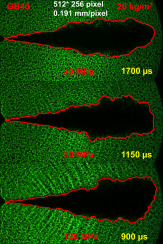当前位置:
X-MOL 学术
›
Fuel Process. Technol.
›
论文详情
Our official English website, www.x-mol.net, welcomes your
feedback! (Note: you will need to create a separate account there.)
Experimental study on non-vaporizing spray characteristics of biodiesel-blended gasoline fuel in a constant volume chamber
Fuel Processing Technology ( IF 7.2 ) Pub Date : 2018-09-01 , DOI: 10.1016/j.fuproc.2018.05.009 Shubhra Kanti Das , Kihyun Kim , Ocktaeck Lim
Fuel Processing Technology ( IF 7.2 ) Pub Date : 2018-09-01 , DOI: 10.1016/j.fuproc.2018.05.009 Shubhra Kanti Das , Kihyun Kim , Ocktaeck Lim

|
Abstract Detailed investigation of the spray phenomenology of liquid fuel injection is the primary step to understand better and predict the physical characteristics involved in fuel spray and atomization process. This study focuses on non-vaporizing transient spray characteristics of neat gasoline and biodiesel addition (10%, 20% and 40% by volume) to gasoline in three different ratios under low load and different injection pressure conditions. Different ambient gas densities and injection pressures were tested, which ranged from 10 to 20 kg/m 3 and 40 to 120 MPa respectively, with a fuel temperature of 323 K. A z-type shadowgraph was utilized as an optical method to capture the highly transient spray development at 40000 frames per second and a modified image processing algorithm was implemented to determine the spray characteristics. The image processing results revealed that an increase in injection pressure significantly accelerates the spray development process while penetration length increases with the increment of biodiesel fraction. Differences in penetration lengths were much significant under lower injection pressure; however, a further increase in injection pressure diminishes the differences in tip penetration. The spray cone angle was increased for higher gasoline content which promotes a larger spray width and as a consequence, neat gasoline exhibited a larger spray area and volume. However, after a certain period of injection start, spray area and volume of neat gasoline and 10% biodiesel-blended gasoline were surpassed by 20% and 40% biodiesel-blended gasoline. In contrast, a decrease in droplet size was observed according to breakup regimes under high injection pressure and low ambient density. These results imply that the higher biodiesel blending fraction has poor air-fuel mixing capability compared to neat gasoline, and the risk of liquid impingement on the cylinder wall becomes higher if the blended-gasoline contains higher biodiesel percentage.
中文翻译:

生物柴油混合汽油在恒容室不汽化喷雾特性的实验研究
摘要 对液体燃料喷射的喷雾现象学进行详细研究是更好地了解和预测燃料喷雾和雾化过程中涉及的物理特性的首要步骤。本研究的重点是在低负荷和不同喷射压力条件下,以三种不同比例向汽油中添加纯汽油和生物柴油(按体积计 10%、20% 和 40%)的非汽化瞬态喷雾特性。测试了不同的环境气体密度和喷射压力,其范围分别为 10 至 20 kg/m 3 和 40 至 120 MPa,燃料温度为 323 K。利用 z 型阴影图作为一种光学方法来捕获高度以每秒 40000 帧的速度进行瞬态喷射,并实施了改进的图像处理算法来确定喷射特性。图像处理结果表明,注射压力的增加显着加速了喷雾发展过程,而穿透长度随着生物柴油分数的增加而增加。在较低的注射压力下,穿透长度的差异非常显着;然而,注射压力的进一步增加会减少针尖穿透的差异。对于更高的汽油含量,喷雾锥角增加,这促进了更大的喷雾宽度,因此,纯汽油表现出更大的喷雾面积和体积。然而,喷射开始一段时间后,纯汽油和10%生物柴油混合汽油的喷射面积和体积被20%和40%生物柴油混合汽油超过。相比之下,根据在高注射压力和低环境密度下的破碎方式,观察到液滴尺寸减小。这些结果表明,与纯汽油相比,较高的生物柴油混合分数具有较差的空气燃料混合能力,如果混合汽油中含有较高的生物柴油百分比,则液体撞击气缸壁的风险会更高。
更新日期:2018-09-01
中文翻译:

生物柴油混合汽油在恒容室不汽化喷雾特性的实验研究
摘要 对液体燃料喷射的喷雾现象学进行详细研究是更好地了解和预测燃料喷雾和雾化过程中涉及的物理特性的首要步骤。本研究的重点是在低负荷和不同喷射压力条件下,以三种不同比例向汽油中添加纯汽油和生物柴油(按体积计 10%、20% 和 40%)的非汽化瞬态喷雾特性。测试了不同的环境气体密度和喷射压力,其范围分别为 10 至 20 kg/m 3 和 40 至 120 MPa,燃料温度为 323 K。利用 z 型阴影图作为一种光学方法来捕获高度以每秒 40000 帧的速度进行瞬态喷射,并实施了改进的图像处理算法来确定喷射特性。图像处理结果表明,注射压力的增加显着加速了喷雾发展过程,而穿透长度随着生物柴油分数的增加而增加。在较低的注射压力下,穿透长度的差异非常显着;然而,注射压力的进一步增加会减少针尖穿透的差异。对于更高的汽油含量,喷雾锥角增加,这促进了更大的喷雾宽度,因此,纯汽油表现出更大的喷雾面积和体积。然而,喷射开始一段时间后,纯汽油和10%生物柴油混合汽油的喷射面积和体积被20%和40%生物柴油混合汽油超过。相比之下,根据在高注射压力和低环境密度下的破碎方式,观察到液滴尺寸减小。这些结果表明,与纯汽油相比,较高的生物柴油混合分数具有较差的空气燃料混合能力,如果混合汽油中含有较高的生物柴油百分比,则液体撞击气缸壁的风险会更高。











































 京公网安备 11010802027423号
京公网安备 11010802027423号